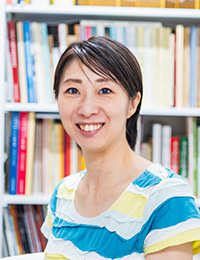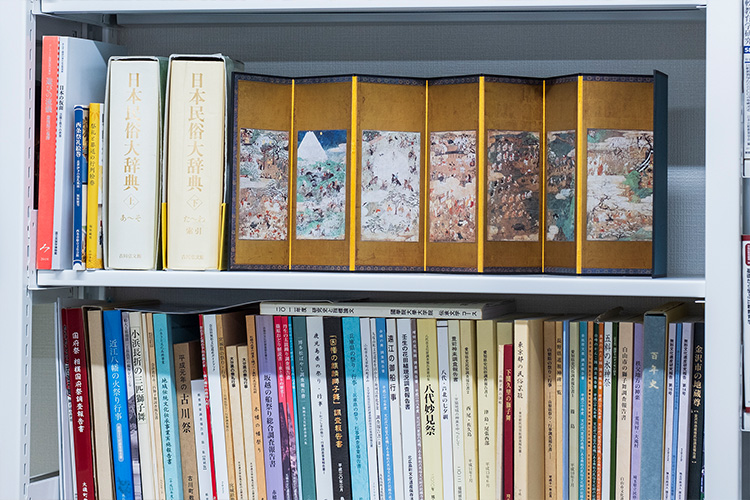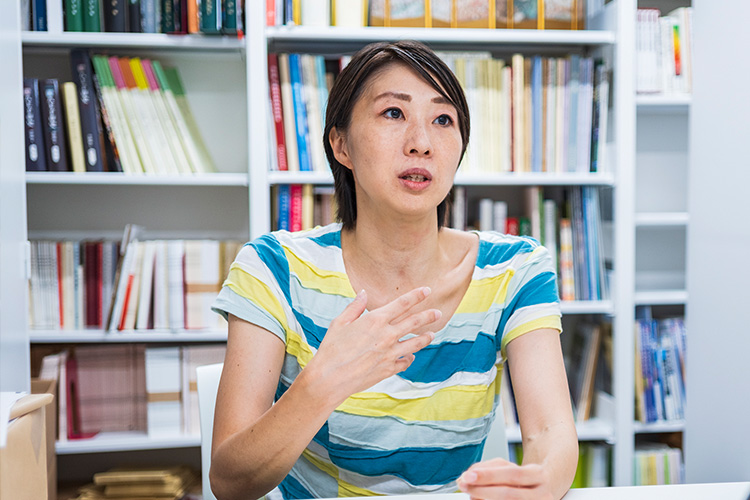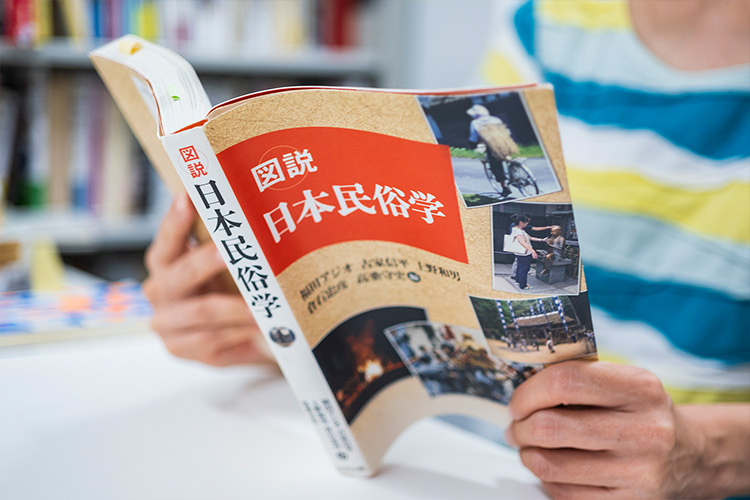
活動レポート


- ”個”と”集”とSDGs -
![]()
![]()
![]()
![]()
![]()
![]()
![]()
![]()

帝京大学文学部 日本文化学科 講師 髙久 舞
2010年から2018年の間、國學院大學研究開発推進機構 研究開発推進センター非常勤研究員を務める。2017年から現在に至るまで國學院大學文学部 日本文学科兼任講師 を務めつつ、2018年から 神奈川県教育委員会教育局生涯学習部文化遺産課専門職員(非常勤)、2019年から昭和女子大学人間文化学部 歴史文化学科兼任講師、お茶の水女子大学生活科学部非常勤講師を兼任する。2021年から帝京大学文学部 日本文化学科講師となり現在に至る。

民俗学は人々の生活の中に蓄積された文化や伝承を研究する学問です。社会に蓄積された人の叡智は千差万別・多種多様で探求に終わりはありません。ユニークで優れた知恵を抽出し、現代の課題解決に役立てることも可能です。中でも私は、祭りや行事で演じられる” 芸能”を専門に研究しています。盆踊りから、神事にまつわる神楽、さらには地域で受け継がれている能劇や歌舞伎といったものまでさまざまです。芸能は衣食住に関係してはいないものの、長い年月に渡り継承され現代に受け継がれています。なぜここまで人は芸能に没頭するのか、そこには人間社会をより良く考えるための重要なテーマが隠されています。
注目しているのは才覚を持つ個と、芸能を継承していく集団との関係性です。基本的に芸能は、進行の段取りから、関係者への計らいに始まり、神事と結びつきます。すべてに役割があり、それぞれの家や個人が担っていきます。一方で、芸能や祭り全体は地域や集落といった集団全体のイベントであり、個として関わる人間たちも、それらを見届けて地域の発展を願う集団の人々もどちらもいなければ成立しません。たとえば、芸能に突出した能力のある人間が祭りを取り仕切ろうとしてもうまくいかない。あくまで芸能は集団のものですから集団全体における合議といったことが欠かせません。一方、芸能のそれぞれの役割を素人が急拵えで埋めようとするのも困難です。個に継承されるノウハウに基づき芸能や祭りが運営され、芸事でも締まりのある立ち振る舞いがあって祭りに華が生まれます。私はこうした関係性を、固的因由と集合的因由という言葉を用い区別しています。この 2つの関係がどのように相互影響を与えているのかが地域の芸能を理解する上で欠かせません。

分析にあたって重要なのは、コミュニティの中にあるキーパーソンを発見することです。これを私はキーパーソン研究と呼んでいます。まず対象となる地域社会を見学し観察しながら、1つの特異点となる人物を中心に起こっている事象を可視化します。その上で文献、土地の歴史、文化性を調査しながら、地域社会における芸能の役割を把握していくのです、例として、秋田県のあるコミュニティでは、お祭りがある時に”芸人”という人を外部から呼びます。かつては”ボサマ”と呼ばれていました。これは、お坊様、つまり座頭のことです。楽器を弾いたり歌を歌ったりする。これは、北東北の方で伝えられている座頭の芸が系譜になっていて、それが現代にも続いているのです。文献でたどってみたところ明治ぐらいまで遡れるのですが、ここが調査の限界でした。おそらくは、さらに以前より続いてきた系譜だと思います。座頭というキーパーソンにフォーカスすると、その地域における祭りや、さらに広いエリアの文化や風習が浮かび上がってくるため、個と集団との関わりや民俗の歴史や変遷を調査分析しやすくなり、現代につながる風習への理解が一気に深まって行きます。

現代における祭りや芸能の課題は、少子高齢化や都市への人口集中によって存続の危機にあります。全国で地域の高齢化が進み、祭りや芸能が立ち行かないために外部の人間を入れて継承を図るケースもありますが、うまくいくのは稀です。決して外部を受け入れたくないというわけではなく、むしろ、外部を受け入れようと頑張りすぎてしまい、内側の人が疲弊してしまうケースが多く見られます。以前、神奈川の芸能に関わったことがあります。コロナ禍で継承が薄れてしまい、さらに少子高齢化の影響で継承が難しくなってきた。そこで、外から人を入れ芸能の継承を図ったのです。運良くその方が才能に溢れた方で技術的な継承がうまく行ったかと思いきや、技術に傾倒し、芸能に対しての個人的な見解や関与を深めすぎてしまい、集団のための芸能との乖離が起こりました。結果、一旦その方に抜けてもらうことになってしまったのです。一方で、今後の存続を考え隣町の小学校に芸能を教えに行くことになった例があります。しかしこちらは、自分達がやらない芸能に意味があるのかと地域の人たちが考え、前に進めなくなってしまいました。自分の芸能を集団として関わりのない人たちが担っていくことに価値が見出せなくなった、と言い換えてもいいかもしれません。どちらも、芸能という存在の本質的な意味を示している事例だと考えています。芸能に長けている個ではなく、集団として芸能を継承することの難しさも感じることができます。
個と集団の関係性の中には、家元が存在するケースもあります。地域芸能でも、代々重要な役を担う家があるケースも多く見られます。こうした地域は比較的安定して祭りが継承されています。私はこうした家元の存在を地域における芸能の精神的支柱であると感じることがあります。芸事は系譜として続いていると考える風潮も強いことから、集団において家元の存在は安心材料の一つとなり得ます。一方、継承する家元の方では、芸事の技術の継承はもちろん、集団における重要な役割を継承するという覚悟が大きなものになっています。もちろん、芸事は時代のニーズに合わせて改良されたりしながら次の時代へと継承されて行きます。同じく集団は、歴史的に様々な選択をしながら存続を第一義に考えています。結果的に、原初のものから少しずつ変わっていくことの方が自然です。ある程度現代の感覚でも理解できる芸能が残っていきますし、そうじゃないものはある程度淘汰されていく傾向が強いと言えます。

ここに我々の学問と、SDGsの接点を見つけることができます。たとえば、時を遡ることは不可能ですから、今あるもので未来をどのように構築するのか、未来において必要なものを今の技術でどう作り出すかが重要になることは言うまでもありません。たとえば炭坑節は福岡の筑豊炭田で歌われた民謡ですが、その後洗練されながら全国に広まり、今や盆踊りの定番民謡となっています。仮に伝統にこだわりすぎた場合、福岡以外では炭坑節を楽しむことは良くないことだとなってしまっていたかもしれません。芸能の主体となる集団は、時代に合わせて様々な年齢の人間が内包されていますから、現代を生きている感覚と乖離していけば継承することが億劫になる可能性があります。したがって、伝統的な芸能でもいろんな現代要素を取り入れることは重要ですし、過去の芸能もそうやって取捨選択して生き残ってきたものだと断言できます。今ではJ-Popをかける踊る盆踊りだってありますが、芸能の形は代わっても、それを楽しいと感じる集団自体の存続には影響はないはずです。現代の集団に受け入れられているものには、ある種の意味と価値があるのです。
SDGsも同様ではないでしょうか。社会そのものの未来を作り続けるには、過去から繋がっているあらゆる叡智を受け継いでいく必要があり、そのためには現代にある社会の資産を見つめながら過去からの変遷を理解することが重要だと言えます。芸能の継承と同じで、自分たちの文化の継承として、自分たちが続けていく覚悟と同時に、社会全体の変化や良いところは良いものだと認め摂取していくことも必要なのです。SDGsも芸能と同じように、私たちの生活と表裏一体なのですから、集団としての社会を継承するために、個々人がより新しい社会を作るための貢献に目を向けていくということが重要なのではと感じています。